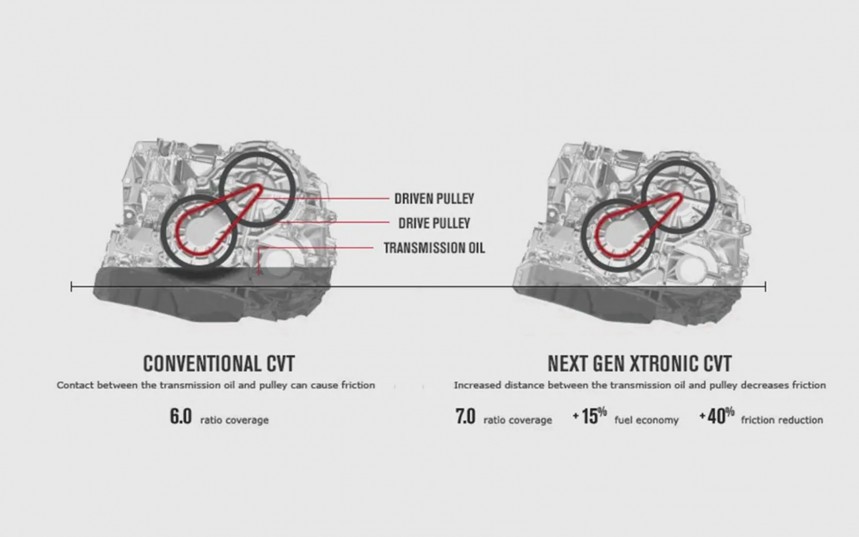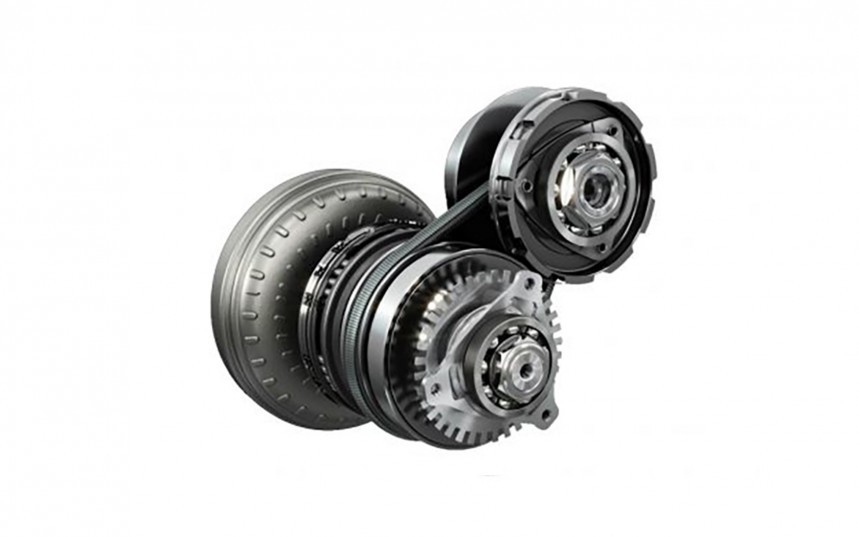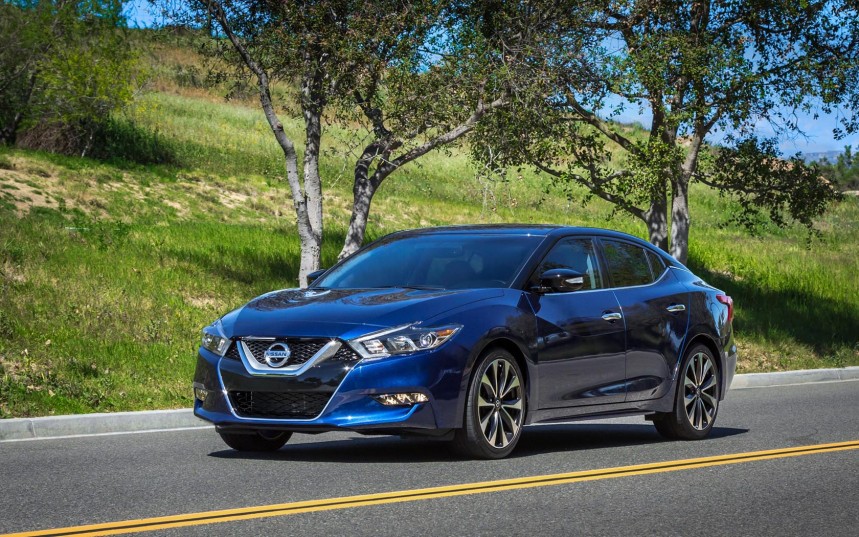Nissan has been using CVTs in its vehicles for nearly twenty years. The first generation launched in 2002 was met with mixed reviews as some owners reporting multiple issues. Almost two decades later, the Japanese manufacturer claims to have solved all the problems, and says the third-generation XTronic delivered in most of the current models is close to CVT perfection.
The way this type of transmission works is not that difficult to understand. It uses a heavy-duty drive belt (or sometimes chain) that operates within a hydraulically triggered, variable pulley system. It moves gears up or down in a smooth motion resulting in stronger acceleration and increased fuel economy.
A CVT is technically an automatic gearbox because it doesn’t require the use of a clutch to change gears, but the major difference is that it does not have any conventional fixed gears.
Nissan states that their XTronic CVT offers rapid, seamless acceleration, significant improvement in fuel economy, and a lighter, more compact unit. Moreover, with fewer moving parts, the friction and heat generated are minimal, so it is more efficient and durable than a conventional transmission.
Due to these theoretical advantages, most of the current models in Nissan’s lineup use this CVT. These include the mighty Pathfinder, Armada, Murano, Sentra, Maxima, or Micra.
However, customers have reported a multitude of problems ever since the first version was released and some of these issues persist even with the current-generation Xtronic. The main complaint is that when accelerating at low speeds, some owners experience shuttering and shaking of the gearbox, which seems to struggle to get up to speed.
In most cases, this problem happened while the vehicles were still covered by the factory warranty, so dealerships fixed the issues by reprograming the gearboxes and replacing parts of the pulley system.
Another reported issue is the painfully slow response time. A CVT feels different when the driver pushes the accelerator, increasing power smoothly and generally slower than a capable fixed-gear transmission, although manufacturers advertise the contrary.
But owners have complained that in some cases, the sluggishness is far too evident, and this can have extremely dangerous outcomes. The main concern of those who reported this issue was that the car would have trouble getting up to speed in critical driving situations like overtaking.
Nissan’s XTronic has also gained a reputation for being loud. This is another real-life problem that is not unique to the Japanese carmaker’s CVT and goes against another main advertising point.
All these problems are mainly caused by overheating, and many experienced mechanics who studied the transmission concluded that its cooling system was inadequately designed.
Apart from the problems that we already covered, certain overheating Xtronic transmissions caused cars to suddenly enter fail-safe mode, which instantly limits the power of the drivetrain, causing potentially dangerous situations.
This was the main issue reported in a class-action lawsuit that involved 2012-2017 Sentras sold in the U.S. equipped with the Xtonic CVT. The case was eventually dismissed, but concerns remained. Nissan never publicly acknowledged any wrongdoing but provided support for any failing CVT and, in some cases, even extended affected customers' warranties.
The current generation of the Xtronic promises to address these issues and comes with a five-year/60,000-mile (96,560 km) warranty.
Those who are thinking of buying a new Nissan should not completely avoid this transmission, but they should know its history, consult current owners for accurate feedback and make sure they understand the conditions and benefits of the warranty when purchasing the vehicle.
One thing is certain, the Xtronic and CVTs, in general, are innovative but far from perfect, flawless gearboxes.
A CVT is technically an automatic gearbox because it doesn’t require the use of a clutch to change gears, but the major difference is that it does not have any conventional fixed gears.
Nissan states that their XTronic CVT offers rapid, seamless acceleration, significant improvement in fuel economy, and a lighter, more compact unit. Moreover, with fewer moving parts, the friction and heat generated are minimal, so it is more efficient and durable than a conventional transmission.
However, customers have reported a multitude of problems ever since the first version was released and some of these issues persist even with the current-generation Xtronic. The main complaint is that when accelerating at low speeds, some owners experience shuttering and shaking of the gearbox, which seems to struggle to get up to speed.
In most cases, this problem happened while the vehicles were still covered by the factory warranty, so dealerships fixed the issues by reprograming the gearboxes and replacing parts of the pulley system.
But owners have complained that in some cases, the sluggishness is far too evident, and this can have extremely dangerous outcomes. The main concern of those who reported this issue was that the car would have trouble getting up to speed in critical driving situations like overtaking.
Nissan’s XTronic has also gained a reputation for being loud. This is another real-life problem that is not unique to the Japanese carmaker’s CVT and goes against another main advertising point.
All these problems are mainly caused by overheating, and many experienced mechanics who studied the transmission concluded that its cooling system was inadequately designed.
Apart from the problems that we already covered, certain overheating Xtronic transmissions caused cars to suddenly enter fail-safe mode, which instantly limits the power of the drivetrain, causing potentially dangerous situations.
The current generation of the Xtronic promises to address these issues and comes with a five-year/60,000-mile (96,560 km) warranty.
Those who are thinking of buying a new Nissan should not completely avoid this transmission, but they should know its history, consult current owners for accurate feedback and make sure they understand the conditions and benefits of the warranty when purchasing the vehicle.
One thing is certain, the Xtronic and CVTs, in general, are innovative but far from perfect, flawless gearboxes.












